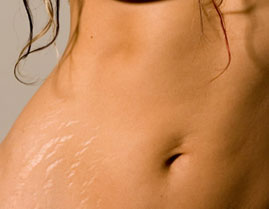Stretch marks can be detrimental to a person's self esteem. Both women and men buy the numerous creams, oils, and rubs that are advertised as being the cure to unsightly streaky lines, but they can only ever improve the look of them but not remove them completely. A new advance in technology has recently seen lasers used to remove stretch marks, but how effective are they?
Stretch marks are located in the dermis which is the middle layer of skin under the outer epidermis. They occur when the skin is quickly stretched beyond its limit and the tissue is torn. When the connective fibres break, this disrupts the collagen production causing breaks to appear on the surface of the skin. These marks are reddish purple to begin with, fading to a whitish colour as they mature. Generally occurring where fat is stored, in the abdomen, thighs, hips, arms, and breasts, it can cause people to suffer from low self confidence.

Most of the people who suffer from stretch mark are women as their bodies stretch during pregnancy. But bodybuilders, those who have experienced extreme weight change and even some teenagers going through rapid body growth in puberty also display unsightly marks on their outer layer of skin. The propensity towards stretch mark creation is hereditary, so the chances are high that if your mother suffered from stretch marks, you will as well. Unfortunately, not everyone is a good candidate for laser stretch mark removal as people with darker skin could suffer unsightly side effects such as a lightening or darkening of their natural pigmentation around the stretch marks.
Technological advancements in laser stretch mark removal have come a long way since the early 1980s. It is now done by a pulsed-dye laser that is also used to treat vascular problems. The wavelength and duration of the energy ensures that it is a safe and non-invasive procedure. Generally speaking, mature white stretch marks or those that are more textured are difficult to treat, but newer fractional lasers are now being used with more success. The process of stretch mark removal with the use of lasers involves puncturing microscopic holes into the dermis and encouraging the production of collagen in order to fill in the stretch marks from the inside out.
- Pulsed-dye Lasers - the same lasers used in vascular surgery. This non-invasive procedure is used to treat recent stretch marks that are pink, red, or purple.
- Fractional Lasers - a newer technology that is used on mature white marks, or those that are more textural.
The procedure is fairly straight forward with the more recent stretch marks of pink purple and red being easier to remove than the more mature white ones, and takes only a few minutes. Anaesthesia is not even necessary as most patients report the pain as being insignificant, as a pinching or needling sensation.
As this is such a safe procedure, there are relatively few side effects. Patients will experience a slight redness or swelling around the area for the following few days, but there will be no long term damage to the epidermis. Only those with darker skin tones are likely to suffer post inflammatory hyperpigmentation (dark spots) or hypopigmentation (white spots) on perhaps even a permanent basis.
Unfortunately, stretch marks are a cosmetic problem not a health hazard; therefore, laser stretch mark removal is considered a cosmetic procedure which is not covered under most insurance plans. The price per session can range from $300 to $1,500, based on the specific area of stretch marks in question, and patients can require anything from 2 to 6 repeat treatment sessions. Most clinics offer financing plans to help patients but be aware of the terms and conditions.
The decision to undergo laser treatment to remove stretch marks is a personal one. As there is no risk of infection, no blood loss, and no recovery time, people are easily convinced that it is a quick-fix solution to their unsightly problem. Unfortunately, the results are not guaranteed and according to many doctors and plastic surgeons, stretch marks can never be fully removed. It is a costly, time consuming decision that may not produce the desired results. It is important to schedule a consultation at a reputable clinic to learn if your individual case of stretch marks can be removed by lasers.